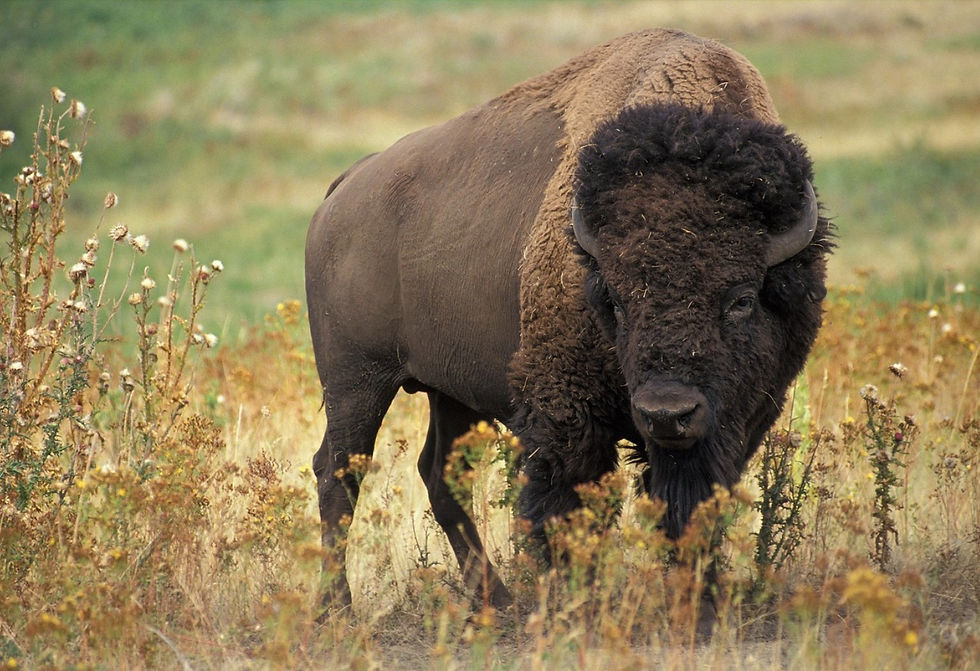Bison, also known as American buffalo, is a species of large, shaggy-haired bovine native to North America. These majestic creatures once roamed the prairies in huge herds, but their populations were greatly reduced by hunting in the late 19th and early 20th centuries. Today, bison have made a comeback, with thriving populations in both wild and domesticated settings.

The American bison is the largest terrestrial animal in North America and can weigh up to 2,200 pounds. Bison have a distinctive appearance, with a massive head, humped shoulders, and short, curved horns. Their shaggy coats provide protection from the cold in the winter, and their massive size and strength make them formidable opponents for predators such as wolves and bears.
Bison are typically found in grasslands and prairies, where they feed on a variety of grasses and forbs. They are known for their massive size and strength, which allows them to forage for food in areas that other herbivores cannot reach. Bison are able to uproot and break through tough grasses and forbs, exposing the tender shoots and leaves underneath.

In addition to grasses and forbs, bison are also known to feed on shrubs, bark, and leaves. This diverse diet allows them to survive in areas with limited food resources, and their strong digestive systems enable them to extract the maximum amount of nutrients from their food.
Bison are known for their grazing behavior, which helps to maintain the health of grasslands and prairies. Their trampling behavior creates bare patches of ground, which provides a suitable habitat for many species of plants and animals. Additionally, their grazing behavior helps to control invasive species and maintain the diversity of the ecosystem.

In the winter, when food is scarce, bison are able to survive by relying on their stored body fat. They are able to endure long periods of food scarcity, making them well adapted to the harsh conditions of the prairies.
In the late 19th and early 20th centuries, bison populations were nearly decimated by hunting. At their lowest point, only a few hundred individuals remained in the wild. Conservation efforts, however, have helped bring bison back from the brink of extinction, and today there are an estimated 500,000 bison in North America.

Bison play a significant role in both cultural and ecological systems. For many Native American tribes, bison are a central part of their spiritual and cultural identity, and their meat and hides were an important source of food and clothing. Today, bison are also valued for their ecological impact, as they play a key role in maintaining the health of grasslands and prairies through their grazing and trampling behavior.
In addition to their ecological importance, bison are also valued for their meat. Bison meat is lean and flavorful, and is now widely available in specialty markets and restaurants. Bison ranching has become a growing industry, with many ranchers raising bison for their meat, hides, and other products.

Bison are highly social animals and live in large herds that can number in the hundreds. The social structure of bison herds is hierarchical, with a dominant bull leading the group. The dominant bull is usually the largest and strongest male in the herd and is responsible for mating with the cows and protecting the herd from predators.
In addition to the dominant bull, bison herds also have submissive bulls who play a supportive role in the herd. Submissive bulls may help to protect the herd from predators and may mate with cows if the dominant bull is not present. In some cases, submissive bulls may eventually challenge the dominant bull for the leadership position in the herd.

During the mating season, which typically occurs in the summer, the dominant bull will mate with several cows. After mating, the cow will carry the calf for approximately nine months before giving birth. Bison cows usually give birth to a single calf, although twins are not uncommon. Calves are born in the spring and are strong and precocial, meaning they are able to stand and nurse within hours of birth.
After giving birth, the mother bison will nurse her calf for several months, during which time the calf will grow rapidly. The mother and calf will remain together for several years, with the calf eventually leaving the herd to form its own herd or join a male group.

Raising bison young is a critical part of the species' survival, and mother bison take great care to protect their young from predators and other threats. Bison cows usually give birth to a single calf, although twins are not uncommon. Calves are born in the spring and are strong and precocial, meaning they are able to stand and nurse within hours of birth.
After giving birth, the mother bison will nurse her calf for several months, during which time the calf will grow rapidly. The mother and calf will remain together for several years, with the calf eventually leaving the herd to form its own herd or join a male group.

The average life expectancy of a bison is around 15 to 20 years in the wild, although some individuals have been known to live for up to 30 years. In captivity, bison can live for up to 25 years, but their life expectancy is often shorter due to the stress of confinement and the lack of space to roam.
At birth, a bison calf typically weighs between 50 to 70 pounds and is approximately 3 feet tall at the shoulder. Over the course of its life, a bison can grow to be up to 6 feet tall at the shoulder and weigh up to 2,000 pounds. The size and strength of adult bison makes them one of the largest mammals in North America, and they are an important component of the ecosystem.

Comments